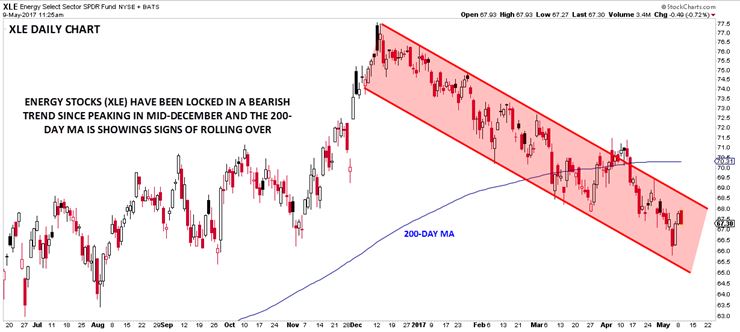For many markets, it feels as if the mid-December Federal Reserve meeting marked a turning point of sorts: that's when the dollar, 10-year treasury yields, and oil prices all peaked. Despite plenty of "risk-on" developments, none of those markets have been able to eclipse their mid-December highs.
Given the drop in oil prices over the last five months (and especially over the last couple of weeks), it's not surprising that the energy sector (XLE) has also turned lower since December. As the chart below shows, the sector is trading off around 13% from its peak around $77.00, despite general strength in the overall stock markets.

Source: Stockcharts.com
The energy sector has been locked in a clear bearish channel over that period, with each minor rally encountering fresh selling pressure. More to the point for longer-term investors, the 200-day moving average is flattening out and at risk of turning lower, suggesting that the long-term trend is shifting in favor of the bears.
On a relative basis, the picture is arguably even more ominous for bulls. As the weekly chart of the sector against the overall market (XLE/SPY) shows, energy stocks have been lagging the overall market for years:

Source: Stockcharts.com
With this year's breakdown from the 2016's "bearish flag" pattern, the long-term underperformance of energy stocks could carry over through 2017 and beyond.
The top holdings in XLE include Exxon Mobile (XOM), Chevron (CVX), Schlumberger (SLB), ConocoPhillips (COP), Occidental Petroleum (OXY), and Kinder Morgan Inc (KMI), all of which are in our universe and are in clear downtrends. We continue to monitor for low-risk opportunities to short these names in line with the longer-term bearish trend.
Of course, the outlook for the energy sector, and every sector, is constantly evolving and if the evidence changes, we'll change our outlook. For now though, path of least resistance for energy stocks remains to the downside.
This research is for informational purposes and should not be construed as personal advice. Trading any financial market involves risk. Trading on leverage involves risk of losses greater than deposits.
Recommended Content
Editors’ Picks
EUR/USD retreats toward 1.0650 after PMI-inspired rebound

EUR/USD loses traction and retreats to the 1.0650 area after rising toward 1.0700 with the immediate reaction to the upbeat PMI reports from the Eurozone and Germany. The cautious market stance helps the USD hold its ground ahead of US PMI data.
GBP/USD fluctuates near 1.2350 after UK PMIs

GBP/USD clings to small daily gains near 1.2350 in the European session on Tuesday. The data from the UK showed that the private sector continued to grow at an accelerating pace in April, helping Pound Sterling stay resilient against its rivals.
Gold flirts with $2,300 amid receding safe-haven demand

Gold (XAU/USD) remains under heavy selling pressure for the second straight day on Tuesday and languishes near its lowest level in over two weeks, around the $2,300 mark in the European session. Eyes on US PMI data.
Here’s why Ondo price hit new ATH amid bearish market outlook Premium

Ondo price shows no signs of slowing down after setting up an all-time high (ATH) at $1.05 on March 31. This development is likely to be followed by a correction and ATH but not necessarily in that order.
US S&P Global PMIs Preview: Economic expansion set to keep momentum in April

S&P Global Manufacturing PMI and Services PMI are both expected to come in at 52 in April’s flash estimate, highlighting an ongoing expansion in the private sector’s economic activity.